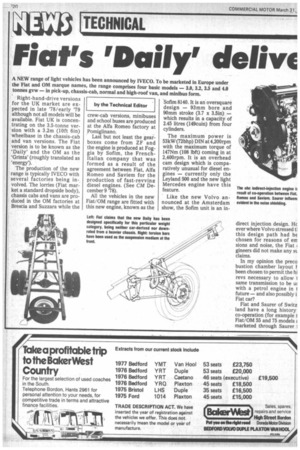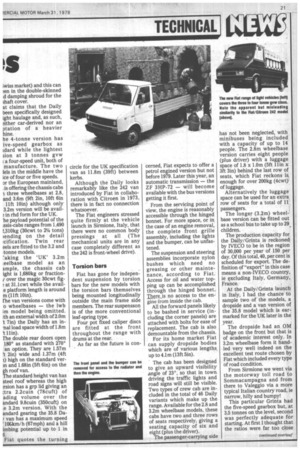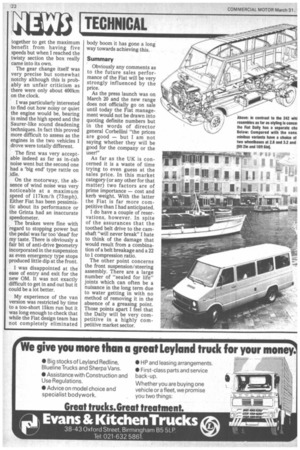Fiat's 'Daily' delivc
Page 22

Page 23

Page 24

If you've noticed an error in this article please click here to report it so we can fix it.
A NEW range of light vehic/es has been announced by IVECO. To be marketed in Europe under the Fiat and OM marque names, the range comprises four basic models — 3.0, 3.2, 3.5 and 4.0 tonnes gvw — in pick-up, chassis-cab, normal and high-roof van, and minibus form.
by the Technical Editor
Right-hand-drive versions for the UK market are expected in late '78/early '79 although not all models will be available. Fiat UK is concentrating on the 3.5-tonne version with a 3.2m (10ft 6in) wheelbase in the chassis-cab and van versions. The Fiat version is to be known as the 'Daily' and the OM as the `Grinta' (roughly translated as 'energy').
The production of the new range is typically IVECO with several factories being in-. volved. The lorries (Fiat market a standard dropside body), chassis cabs and vans are produced in the OM factories at Brescia and Suzzara while the crew-cab versions, minibuses and school buses are produced at the Alfa Romeo factory at Pomiglinano.
Last but not least the gearboxes come from ZF and the engine is produced at Foggia by Sofim, the French. Italian company that was formed as a result of the agreement between Fiat, Alfa Romeo and Saviem for the production of fast-revvine diesel engines. (See CM December 9 '78).
All the vehicles in the new Fiat/OM range are fitted with this new engine, known as the Sofim 8140. It is an oversquare design — 93mm bore and 90mm stroke (3.7 x 3.5in) — which results in a capacity of 2.45 litres (149cuin) from four cylinders.
The maximum power is 53kW(72bhp) DIN at 4,200rpm with the maximum torque of 147Nm (108 lbft) coming in at 2,400rpm. It is an overhead cam design which is comparatively unusual for diesel engines — currently only the Leyland 500 and the new light Mercedes engine have this feature.
Like the new Volvo announced at the Amsterdam show, the Sofim unit is an in direct injection design. Hc ever where Volvo stressed tl this design path had be chosen for reasons of err sions and noise, the Fiat i gineers did not make any st claims.
In my opinion the preco bustion chamber layout t been chosen to permit the hi revs necessary to allow t same transmission to be Lu with a petrol engine in t future — and also possibly i Fiat car?
Fiat and Saurer of Switz land have a long history co-operation (for example t Fiat/OM 55 and 75 models marketed through Saurer I ;wiss market) and this can ?en in the double-skinned Ld damping shroud for the shaft cover.
at claims that the Daily been specifically designed ight haulage and, as such, either car-derived nor an ptation of a heavier hine.
he 4-tonne version has ive-speed gearbox as idard while the lightest sion at 3 tonnes gvw ; a four-speed unit, both of manufacture. The two leis in the middle have the ice of four or five speeds.
or the European mainland, . is offering the chassis cabs three wheelbases at 2.8, and 3.6m (9ft 2in, 10ft 6in lift 10in) although only 3.2m version will be avail? in rhd form for the UK.
he payload potential of the issis-cabs ranges from 1,490 !,310kg (30cwt to 21/4 tons) )ending on the detail !cification. Twin rear eels are fitted to the 3.2 and -tonne models.
Taking the 'UK' 3.2m Leelbase model as an ample, the chassis cab ight is 1,680kg or fraction,/ over the magic 30cwt fig? at 31.1cwt while the avail.e platform length is around m (11ft 10in).
rhe van versions come with o wheelbases — the lwb ;rn model being omitted. ith an external width of 2.0m I 7in) the Daily has an in-nal load space width of 1.8m 't I lin).
The double rear doors open 180° as standard with 270° an option. They are 1.57m ;1. 2in) wide and 1.37m (4ft 1) high on the standard verm and 1.68in (5ft 6in) on the gh roof van.
The standard height van has steel roof whereas the high Tsion has a grp lid giving an :tra 2.2cuin (78cuft) of ading volume over the andard 9.8cuin (350cuft) on ie 3.2m version. With the andard gearing the 35.8 Da7 van has a maximum speed laSkm/h (67mph) and a hill imbing potential up to 1 in 6.
Fiat quotes the turning circle for the UK specification van as 11.8m (39ft) between kerbs.
Although the Daily looks remarkably like the 242 van introduced by Fiat in collaboration with Citroen in 1973, there is in fact no connection whatsoever.
The Fiat engineers stressed quite firmly at the vehicle launch in Sirmione, Italy, that there were no common body pressings at all (The mechanical units are in any case completely different as the 242 is front-wheel drive).
Torsion bars
Fiat has gone for independent suspension by torsion bars for the new models with the torsion bars themselves being mounted longitudinally outside the main frame side members. The rear suspensson is of the more conventional leaf-spring type.
Four pot fixed caliper discs are fitted at the front throughout the range with drums at the rear.
As far as the future is con cerned, Fiat expects to offer a petrol engined version but not before 1979. Later this year, an automatic transmission — the ZF 3HP-72 — will become available with the bus versions getting it first.
From the servicing point of view, the engine is reasonably accessible through the hinged bonnet. For more space, or in the case of an engine removal, the complete front grille assembly, including the lights and the bumper, can be unfastened.
The suspension and steering assemblies incorporate nylon bushes which need no greasing or other maintenance, according to Fiat. Access for oil and water topping up can be accomplished through the hinged bonnet. There.is no access to the engine from inside the cab. All the forward panels likely to be bashed in service (including the corner panels) are attached with bolts for ease of replacement. The cab is also demountable from the chassis.
For its home market Fiat can supply dropside bodies which are of various lengths, up to 4.1m (13ft 5in).
The cab has been designed to give an upward visibility angle of 23°, so that in town driving the traffic lights and road signs will still be visible. Two types of crew cab are included in the total of 46 Daily variants which make up the range. Available for the 2.8 and 3.2m wheelbase models, these cabs have two and three rows of seats respectively, giving a seating capacity of six and eight (plus the driver).
The passenger-carrying side has not been neglected, with minibuses being included with a capacity of up to 14 people. The 2.8m wheelbase version carries eight people (plus driver) with a luggage space of 1.8 x 1.0m (5ft Jim x 3ft 3in) behind the last row of seats, which Fiat reckons is, enough for over 200kg (4cwt) of luggage.
Alternatively the luggage space can be used for an extra row of seats for a total of 11 passengers.
The longer (3.2m) wheelbase version can be fitted out as a school bus to take up to 29, children.
The production capacity for the Daily/Grinta is reckoned by IVECO to be in the region of 30,000 per year of 150 per day. Of this total, 40, per cent is scheduled for export. The definition of "export" in this case means a non-IVECO country, ie excluding Italy, Germany, France.
At the Daily/ Grinta launch in Italy, I had the chance to sample two of the models, a dropside and a van version of the 35.8 model which is ear, marked for the UK later in the year.
The dropside had an OM badge on the front but that is of academic interest only. In 3.2m wheelbase form it handled very well indeed on the excellent test route chosen by Fiat which included every type of road condition.
From Sirmione we went via the motorway toll road to Sommacampagna and from there to Valeggio via a more typical Italian country road, ie narrow, hilly and bumpy!
This particular Grinta had the five-speed gearbox but, at 3.5 tonnes on the level, second was perfectly adequate for starting. At first I thought that the ratios were far too close together to get the maximum benefit from having five speeds but when I reached the twisty section the box really came into its own.
The gear change itself was very precise but somewhat notchy although this is probably an unfair criticism as there were only about 400km on the clock.
I was particularly interested to find out how noisy or quiet the engine would be, bearing in mind the high speed and the Saurer-like sound deadening techniques. In fact this proved more difficult to assess as the engines in the two vehicles I drove were totally different.
The first was very acceptable indeed as far as in-cab noise went but the second one had a 'big end' type rattle on idle.
On the motorway, the absence of wind noise was very noticeable at a maximum speed of 117km/ h (73mph). Either Fiat has been pessimistic about its performance or the Grinta had an inaccurate speedometer.
The brakes were fine with regard to stopping power but the pedal was far too 'dead' for my taste. There is obviously a fair bit of anti-drive geometry incorporated in the suspension as even emergency type stops produced little dip at the front.
I was disappointed at the ease of entry and exit for the new OM. It was not exactly difficult to get in and out but it could be a lot better.
My experience of the van version was restricted by time to a too-short 15km run but it was long enough to check that while the Fiat design team has not completely eliminated body boom it has gone a long way towards achieving this.
Summary Obviously any comments as to the future sales performance of the Fiat will be very strongly influenced by the price.
As the press launch was on March 20 and the new range does not officially go on safe until today the Fiat management would not be drawn into quoting definite numbers but in the words of director general Corbellini "the prices are good — but I am not saying whether they will be good for the company or the user!"
As far as the UK is concerned it is a waste of time trying to even guess at the sales price. In this market category (or any other for that matter) two factors are of prime importance — cost and kerb weight. With the latter the Fiat is far more competitive than I had anticipated.
I do have a couple of reservations, however. In spite of the assurances that the toothed belt drive to the camshaft "will never break" I hate to think of the damage that would result from a combination of a belt breakage and a 22 to 1 compression ratio.
The other point concerns the front suspension/steering assembly. There are a large number of "sealed for life" joints which can often be a nuisance in the long term due to water getting in with no method of removing it in the absence of a greasing point. Those points apart I feel that the Daily will be very competitive in a highly competitive market sector.






















































































































